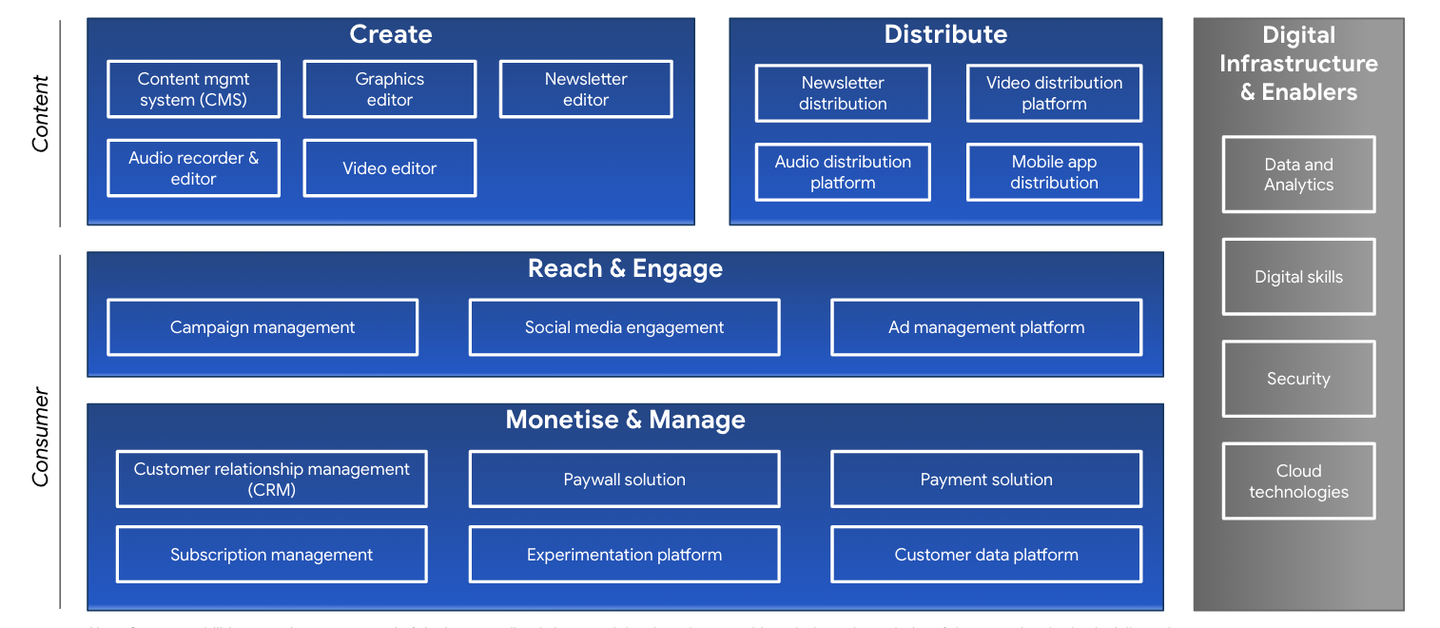The imperative for a purpose-fit technology stack
In a recent interview with FT Strategies, Der Spiegel's Managing Editor of Strategy & Operations - Philipp Lowe - explained that a continuous underinvestment in technology (relative to editorial) is what prevented digital revenue growth.
In fact, our recently released News Sustainability Project involving over 450 publishers has helped us to quantitatively evidence this phenomenon. Leading publishers (those within the top 20% segment with regard to profitability) allocate 24% of their budget to Product & Technology, compared to 18% for other publishers. This suggests that a purpose-fit technology stack can be a differentiator for news organisations.
However, building an appropriate technology stack is not simple - and there are many difficult questions that need to be answered:
- What technology is available?
- What technology do we need?
- Should I build, borrow or buy the technology?
- Who are the best vendors?
As part of our mission to power customer growth within news organisations, we have created this how to guide: Building a technology infrastructure that is fit for a digital-first news organisation.
Alongside the guide, we are also hosting our first webinar on the topic in September 2023 with resident FT technology leaders. If you are interested, you can sign up for the webinar here.
The activities a technology stack needs to enable
At its most basic, a publisher’s technology solutions should power a series of digital operations - these can be divided into four thematic groups:
- Create: Designing and developing digital editorial output such as video, podcast and written journalism;
- Distribute: Pushing out developed content to digital assets including websites, social media and apps;
- Reach and engage: Providing audiences relevant content, as well as delivering joined-up, consistent messaging and marketing campaigns across different channels; and
- Monetise and manage: Collecting and maintaining user data to establish a ‘single customer view’, as well as monetising audiences in multiple ways including for their consumption of digital content.
Crucially, each of these is underpinned by a robust digital infrastructure and set of enablers. These are foundational solutions, such as data and analytics, publishers must have in order to unlock the many coveted benefits digital-first models can provide including consistent customer journeys and an intimate understanding of user behaviours.
The image below sets out an example of a technology architecture, which includes a range of capabilities, tools and solutions, that could help publishers to effectively deliver the above operations. For example, to:
- Create content, a content management system (CMS) is an unsurprising and fundamental capability publishers rely on to rapidly create and share digital content without requiring technical expertise;
- Distribute content, there is a growing range of off-site hosting solutions which store data-heavy content such as audio and video, easing the burden on publishers’ back-end technology infrastructure to avoid hampering front-end user experience;
- Reach and engage audiences, solutions such as social media engagement are supporting publishers to automate the management of content across social platforms in a consistent and timely manner; and
- Monetise and manage audiences, publishers are using customer data platforms to join up all reader records to build a ‘single customer view’, while solutions such as subscription management automate operational management of the subscription lifecycle.





Identifying the right technology solutions
Many publishers - as well as organisations in wider industries - are often hamstrung by investing in technology solutions without a clear strategy. This can lead to implementation of technologies that address specific use-cases, but are in isolation of the role that it plays in supporting the organisation's strategic context, and struggle to generate long-term returns.
To avoid this scenario, the following six-steps provide a structured approach for assessing an organisation’s technology needs, a way to ensure the right solutions are selected and a practical path to implementing those chosen solutions:
- Identify needs: Start by understanding the business' overarching strategy and aspirations for the next 3-5 years, and clarify the exact role technology will play in realising those;
- Define use-cases: Consider the specific customer or operational problems that are being addressed with the new technology, as well as what the end outcome will be and how that contributes to the overarching strategy;
- Design the future technology stack: Audit current technology capabilities in the context of the overarching strategy, and uncover gaps that will need to be bridged to help realise the organisation’s future ambition;
- Develop a practical roadmap: Identify the specific tools and solutions that are needed, assessing whether to ‘build’ or ‘buy’, and assess the right vendors that will be used to access those solutions;
- Implement the new technologies: Carefully integrate the new technologies into the current technology architecture; and
- Operate and run: Seamlessly manage the solutions, either upskilling, reskilling, or accessing new talent to unlock their full potential. Additionally strive to continuously improve the technology stack with regular upgrades, both hardware and software.
Choosing whether to ‘build’ or ‘buy’ technology solutions
An inevitable decision publishers face - as articulated in the steps above - is whether to 'build' or 'buy' technology solutions. In most circumstances, there is no one-size fits all approach, and instead ‘build’ vs ‘buy’ decisions depend on several factors including cost, internal resource availability, internal talent, and required time to market.
With an increasing range of off-the shelf solutions available today, publishers that face constraints for resource and investment are finding it easier to buy the solutions they need at an affordable price point. For example, solutions such as Newspack and Ghost, designed with the needs of small publishers in mind, are low-cost ‘all-in-one’ platforms that include dozens of plugins and tools to power the most important operations of a digital-first newsroom.
Other publishers, particularly those that are more sophisticated, find that building solutions in-house provides more control over feature development and better interoperability with its wider technology estate. However, this does come at the expense of more costly continuous improvement and the potential need for advanced internal technology and DevOps teams.
The most successful publishers in the digital age have tended to strike a delicate balance between the two approaches. For example, the Financial Times has developed several solutions from the ground up to address its own challenges, providing flexibility, agility and customisation that off-the-shelf solutions are unable to match. This has been complemented with buying leading-edge off-the-shelf solutions that provide performance benefits in-house solutions find hard to beat.
How FT Strategies can help you
FT Strategies is the consultancy from the Financial Times that works with organisations to accelerate their digital transformation and power customer growth. The FT moved fast and invested proactively to build a best-in-class technology stack that underpins its digital-first business.
We are now sharing this expertise with organisations, in publishing, media and wider sectors, to help support their transition to digital-first businesses. If you want to find out more, please do not hesitate to reach out to us.




